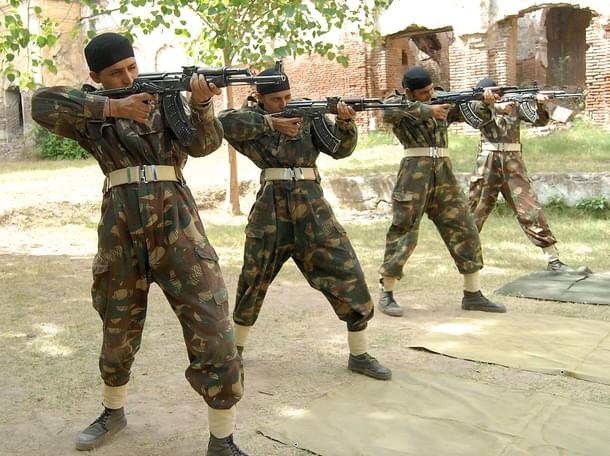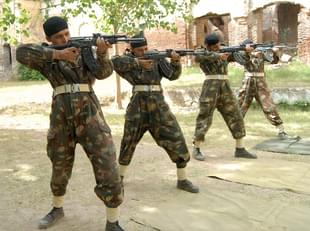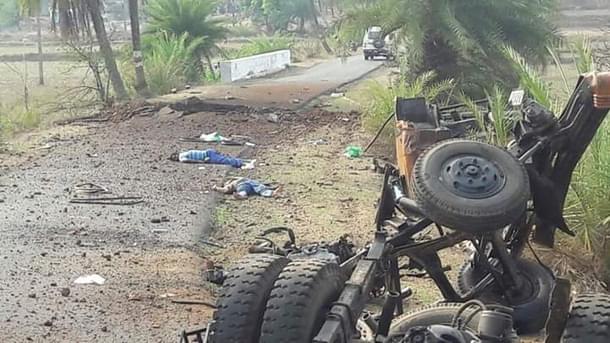Defence
Give The Central Armed Police Forces Their Due
Rakesh Kr Sinha
Apr 30, 2016, 02:11 PM | Updated 02:11 PM IST
Save & read from anywhere!
Bookmark stories for easy access on any device or the Swarajya app.


- The
Central Armed Police Forces, now declared the Armed
Forces of the Union, form the first
line of defence against both external and internal enemies.
- Over the last ten years, 32 officers and 1000 men from CAPF have sacrificed their lives while fighting against terrorists and Naxalites.
- Yet, the One Rank One Pension (OROP) scheme agreed for the defence
forces has been denied to the CAPFs.
- There
is an inherent ruling class conspiracy of pitching one oppressed class (CRPF personnel) against
another oppressed class (marginalized tribals).
A few weeks ago, India was in a state of unofficial mourning, not because of the loss of seven brave Central Reserve Police Force (CRPF) soldiers at Dantewada in Chhattisgarh but because their cricket team had lost a World T20 match against the West Indies.
All news channels were brainstorming in order to figure out the reasons for such a catastrophe (losing a cricket match that broke a billion hearts), while sacrifices made by the CRPF soldiers made no news. No television news channel exhibited any importance to the news of seven unarmed CRPF personnel being blown into pieces by Naxals at Dantewada.
These incidences do not become a subject of countrywide condemnation. Neither are editorials written on these issues nor does prime time television take them up. There are no candle light marches, and the people at India Gate or Jantar Mantar are never seen protesting against such killings. The human rights activists and the progressives are mysteriously silent. It does not make any difference to them if CRPF personnel are blown into pieces. Nobody is seeking ‘azadi’ from such dastardly acts. These people are no ‘Akhalaqs’ and no ‘Rohith Vemulas’. No tears are required to be shed for them.
The Central Armed Police Forces (CAPF), also commonly referred to as ‘para military’, consists of five security organisations: the CRPF, BSF, CISF, ITBP and SSB. These Forces have been declared as the Armed Forces of the Union through different Acts of Parliament by which these were raised. They are our first line of defence against both external and internal enemies, but suffer with all the disadvantages of being equated to the civil services, despite living and performing duties in the most difficult circumstances.
Life of the CAPF personnel in Chhattisgarh is a case in point. This author once got a surprise phone call from a junior who was serving in a forest area in Chhattisgarh. His mobile phone would perennially remain out of the covering area. He said that he was talking from the top of a tall tree, which he had just climbed in the night so that his mobile phone gets some signals. These are the people who are tasked with the responsibility of maintaining internal security in this country.
This includes deployment at the forward posts on the international borders as in the case of BSF and ITBP; fighting Left Wing Extremism (LWE), referred to as Naxals in common parlance, and anti-insurgency operations against secessionist organisations in northeastern states, as in the case of the CRPF; and securing the industrial and strategic installations as in the case of CISF.
One can’t gainsay that the responsibility of guarding India’s national security lies with the CAPFs as of now. This situation has come about because the definition and character of the word ‘enemy’ has undergone a complete transformation post the 1971 era. Now, the enemy has infiltrated into the country and is not restricted only to the borders. Over 200 districts and seven states of India are affected by violent Naxal activity.
In the last 10 years, 32 officers and 1000 men from the CAPFs have sacrificed their lives in the line of duty and more than 7500 men have suffered serious injuries fighting terrorists and Naxals. Sadly, these are unheralded soldiers. Their supreme sacrifices for the motherland have seldom been acknowledged by the Government, the media or the civil society. Their positions in the Government’s schemes have gone from bad to worse.

Until the third Pay Commission, the CAPFs were placed differently and had a separate pay scale. The third Pay Commission brought them at par with the civilian officers and from the year 2004, they have even been denied pension after retirement despite their status as an Armed Force of the Union.
Imagine a CAPF personnel disabled in an operation, medically boarded out of the Force and left without pension. Hard to imagine, but this is the truth. Now, they have to contribute for their pension like civilian officers. Recently, the Government agreed to implement the One Rank One Pension (OROP) scheme for the defence forces, but have denied the same to the CAPFs.
The defence forces are led by their own officers who would have served for almost 35 to 40 years in different positions within the same organisation before heading them. The heads of defence forces fought for and secured the OROP for their men and officers. Unfortunately, the CAPFs are not headed by their cadre officers and are technically and literally orphans in the system, with no one to represent their case before the Government or the Pay Commission. This is one of the many misfortunes of the CAPFs.
In this country, certain sections of the media and the intelligentsia including the younger generation can be seen romanticizing with the Maoist ideology. The Urban Perspective Plan of 2004 of the Maoists proposes to enter the trade unions, unemployed, students and intellectuals. It seems that they have got a fair bit of success in this endeavour.
It is glamorous and intellectually fascinating for many in the academia to talk about ‘displacement of the tribals’, ‘corporate exploitation’ and ‘human rights violation’. These are basically the front organisations which the Maoists have created to use the State structures and legal processes to further their agenda and demoralise the enforcement regime.
The Maoists are also taking the support of external forces inimical to India, whom the Maoists have designated as ‘strategic assets’. Intellectuals with a misplaced belief in ‘revolutionary armed struggle’ and ‘protracted peoples war’ provide a face to cover the violent nature of Maoism, and use their social and academic positions for the propagation of this doctrine.
Naxal agitation, which basically began as a socioeconomic movement, has now become a monstrous and most serious threat to national security. The violent rebuttal by the Naxals is said to have been caused as a result of perpetual discriminatory and exploitative State policy towards marginalised tribal societies.
Unfortunately, the CAPFs are now made to shed their blood to undo the wrongs of the political leadership. They are not even called ‘martyrs’, as this honour is reserved for the defence forces only.
Sometimes, the Maoist strategy too appears to be directionless. There is no point in killing security personnel. If they kill one, the Government will send ten more. The bullets of the Maoists may get over but the numbers of security personnel will never fall short.
For every one vacancy in CAPF, there are roughly hundred candidates to fill in. There are already over a hundred CRPF soldiers in Chhattisgarh engaged in anti-Naxal operations. There is no way that the Naxals can move any further towards their goal by land mining or ambushing security forces. There is no way that a soldier, coming from a similar social and economic background as that of a Naxal, can be seen as a ‘class enemy’. They are both probably from the same class.
If the Maoist intellectuals can sense it, there is an inherent ‘ruling class conspiracy’ of pitching one ‘oppressed’ class against another ‘oppressed’ class in this whole game of containing Naxalism. It is high time that the Naxals see this and make a course correction in their approach. If they have the popular support of the people they claim to represent, they should join mainstream politics and make changes in the system that they are fighting against.
Rakesh Kr Sinha has done M.A. in International Politics and M.Phil. in American Studies from JNU, New Delhi and a LL.B. from Faculty of Law, Delhi University. He joined Government of India Civil Services Allied (CISF:91) and voluntarily retired from the post of DlG in the year 2014 . He is an Associate Member of Institute of Defence Studies and Analyses (IDSA). He is a freelance writer, speaker and a blogger on the subjects of International, Political and Strategic Affairs. Presently he is appointed as the Special Advisor to the Chief Minister, Govt of NCT of Delhi.





